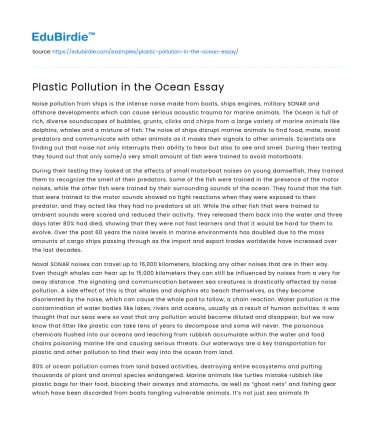Noise pollution from ships is the intense noise made from boats, ships engines, military SONAR and offshore developments which can cause serious acoustic trauma for marine animals. The Ocean is full of rich, diverse soundscapes of bubbles, grunts, clicks and chirps from a large variety of marine animals like dolphins, whales and a mixture of fish. The noise of ships disrupt marine animals to find food, mate, avoid predators and communicate with other animals as it masks their signals to other animals. Scientists are finding out that noise not only interrupts their ability to hear but also to see and smell. During their testing they found out that only some/a very small amount of fish were trained to avoid motorboats.
During their testing they looked at the effects of small motorboat noises on young damselfish, they trained them to recognize the smell of their predators. Some of the fish were trained in the presence of the motor noises, while the other fish were trained by their surrounding sounds of the ocean. They found that the fish that were trained to the motor sounds showed no fight reactions when they were exposed to their predator, and they acted like they had no predators at all. While the other fish that were trained to ambient sounds were scared and reduced their activity. They released them back into the water and three days later 80% had died, showing that they were not fast learners and that it would be hard for them to evolve. Over the past 60 years the noise levels in marine environments has doubled due to the mass amounts of cargo ships passing through as the import and export trades worldwide have increased over the last decades.
Naval SONAR noises can travel up to 16,000 kilometers, blocking any other noises that are in their way. Even though whales can hear up to 15,000 kilometers they can still be influenced by noises from a very far away distance. The signaling and communication between sea creatures is drastically affected by noise pollution. A side effect of this is that whales and dolphins etc beach themselves, as they become disoriented by the noise, which can cause the whole pod to follow, a chain reaction. Water pollution is the contamination of water bodies like lakes, rivers and oceans, usually as a result of human activities. It was thought that our seas were so vast that any pollution would become diluted and disappear, but we now know that litter like plastic can take tens of years to decompose and some will never. The poisonous chemicals flushed into our oceans and leaching from rubbish accumulate within the water and food chains poisoning marine life and causing serious threats. Our waterways are a key transportation for plastic and other pollution to find their way into the ocean from land.
80% of ocean pollution comes from land based activities, destroying entire ecosystems and putting thousands of plant and animal species endangered. Marine animals like turtles mistake rubbish like plastic bags for their food, blocking their airways and stomachs, as well as “ghost nets” and fishing gear which have been discarded from boats tangling vulnerable animals. It’s not just sea animals that are affected by ocean pollution, sea birds that feed mainly or entirely on fish and krill often get stuck in “ghost nets”, mistake rubbish for food and eat fish that have eaten pieces of plastic. There are two types of micro plastics; Primary micro plastic are the tiny particles or fragments of plastic, these include microfibers from clothing and nurdles (tiny plastic pellets) which are no larger than 5mm. The other type of micro plastic is secondary microplastic which are created from the degradation of larger pieces of plastic once they have entered the habitat through the natural weathering, these include plastic bags, straws and fishing nets.
The Great Pacific Garbage patch is equivalent to ten Tasmanias in area, with an estimated weight of 80,000 tonnes and 94% beeing microplastics. It has been created by warm sea currents, holding plastics together creating a “Plastic Island”. It is estimated that by 2050 there will be more plastics in our ocean by weight then there will be fish in the ocean. Every year roughly eight million metric tons of plastic enters our oceans, with currently 150 million metric tons already there.
The main effect of plastics in our oceans is that fish and sea creatures mistake it for their food as it looks and smells like their food. The water underneath the floating mass of plastics is toxic with no light penetrating causing algae blooms and sickness to marine life for animals nearby. Animals that swim near the surface are very vulnerable to getting tangled in loose rubbish or “ghost nets” causing them to starve, suffocate or be eaten by other predators. Fish caught by fishing industries for the consumer market sell fish for human consumption with plastics inbedded in their bodies.
Noise pollution upsets the whale migration up the Mid North Coast past Coffs Harbour causing whales to become acoustically traumatised. Along Coffs coastline there are a number of rivers that deposit plastics/rubbish into the ocean which can wash up along the shore, helping to contribute to more rubbish in the ocean environment.
We can help by collecting any visual rubbish along beaches and river banks, not using as much plastic, by reducing unnecessary items thus reducing imports which come by sea, recreationally more wind powered boats and less fuel driven boats. Both noise pollution and plastic pollution are major issues that need more attention, these issues are killing thousands of marine life and destroying hundreds of habitats. We need to find a solution if we want to protect the future of our oceans.






 Stuck on your essay?
Stuck on your essay?

